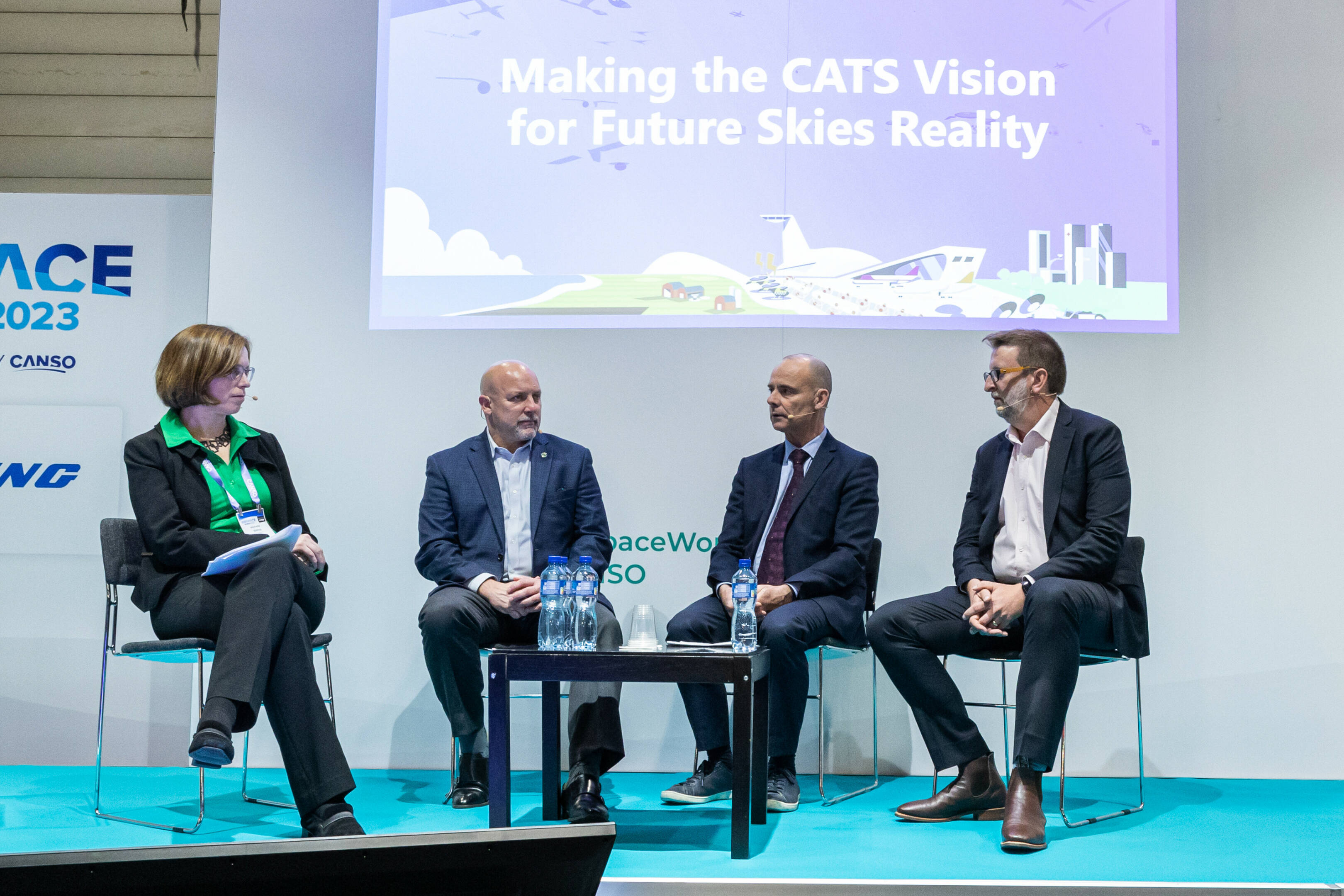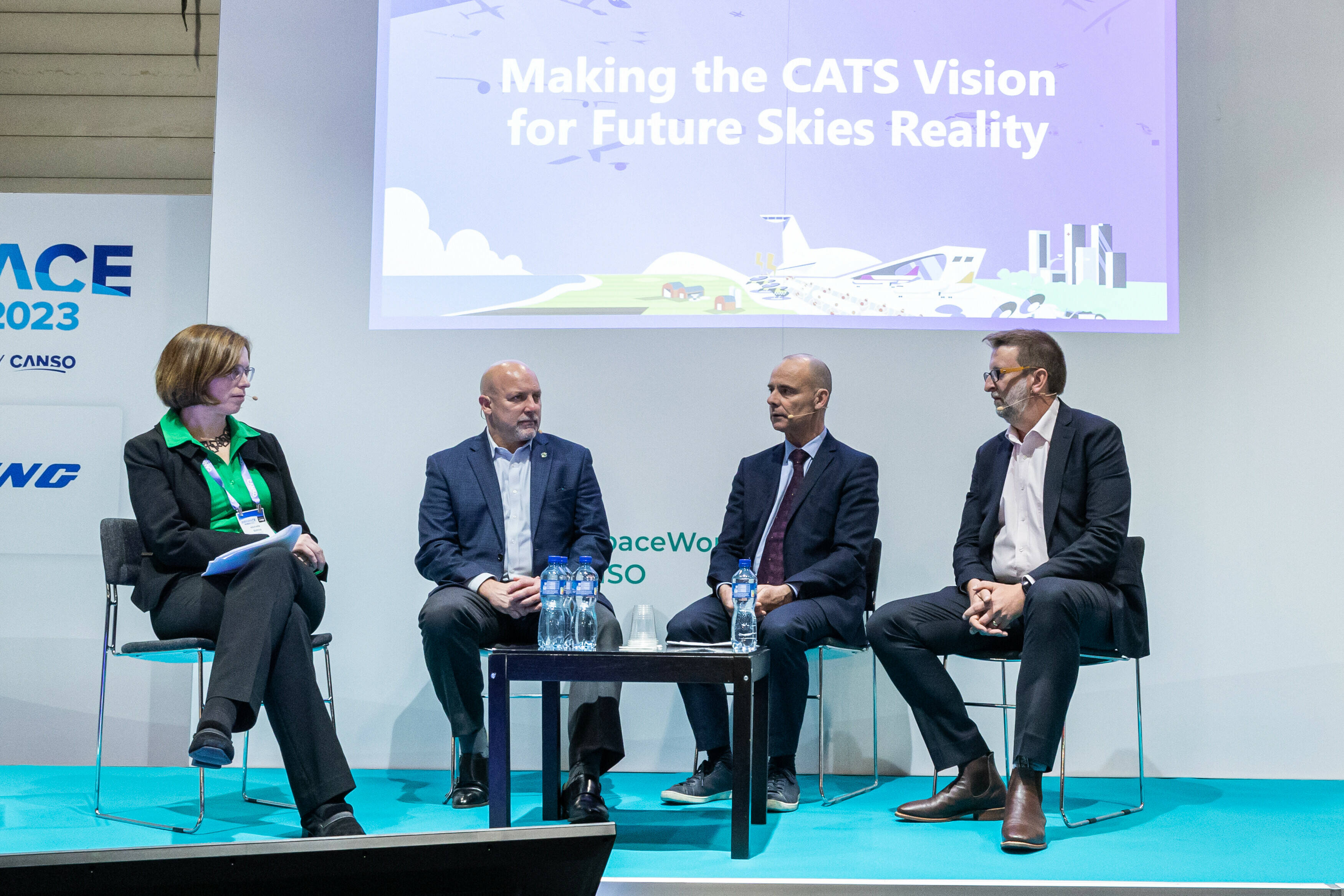An education session on CANSO’s Complete Air Traffic System (CATS) at Airspace World revealed the work being done to make the seamless skies vision a reality.

Airspace Article


“This work programme will enable key stakeholders to coordinate and prioritise their efforts towards realising the vision for the future skies. CATS will continue to provide updates on its progress towards achieving these goals.”
Eduardo Garcia
CANSO’s Manager of European ATM Coordination and Safety.
Taking all the input to date into account, the CATS Global Council will now focus on implementing key milestones from the roadmap. This will not only maintain momentum but also provide accountability for achieving the vision for future skies.
The CATS work programme for the next three years will focus on the following eight areas:
Developing a new Concept of Operations (CONOPS) for global airspace management.
Developing a traffic management integration roadmap for low-level airspace and high airspace, as well as a pathway to advanced air mobility (AAM).
Optimising and simplifying airspace.
Prioritising innovation and digitisation to enhance efficiency and effectiveness.
Ensuring global safety and security in aviation.
Achieving a reduced climate impact through sustainable practices.
Fostering a thriving aviation community.
Exploring new financing mechanisms for air navigation services (ANS).
“This work programme will enable key stakeholders to coordinate and prioritise their efforts towards realising the vision for the future skies,” says Eduardo Garcia, CANSO’s Manager of European ATM Coordination and Safety. “CATS will continue to provide updates on its progress towards achieving these goals.”
The next three years


Airspace Article
Simon Hocquard, Director General of CANSO and Chair of the CATS Global Council, set the scene by asking how the industry can achieve a fully scalable, sustainable and resilient airspace system while safely integrating the ever-growing variety of new airspace users.
Managing the growth in commercial passenger traffic and the diverse performance profiles of new vehicles requires innovation and collaboration.
Recognising that every key player in the airborne vehicle ecosystem had a slightly different view of the future skies, CANSO set up the CATS Global Council to establish a shared global industry vision.
The CATS vision – which took account of the views of the 70 different organisations that make up the Global Council – was released in October 2021, and followed by the development of a roadmap to provide a clear direction for that vision.
In the session at Airspace World, Huy Tran, Director of Aeronautics at NASA Ames Research Center and Parimal (PK) Kopardekar, Director of NASA Aeronautics Research Institute (NARI) also took to the stage to announce a CANSO-NASA partnership. This led to an invitation for all innovators to an event taking place in California later this year.
The CATS Global Council’s collaboration with NASA will drive the creation of synchronised roadmaps by bringing together the latest research from around the world. This should provide some unique insights into the multitude of challenges and opportunities ahead.
The session also featured a panel discussion on "Shaping our future skies – the role of academia" moderated by PK (NASA). This explored exactly how academic institutions can contribute to the strategies that will make the air traffic management industry sustainable, efficient, safe, fair, intelligent, and interoperable.
Several top aviation universities and research centres were also invited to present their work and explain how it could contribute to achieving the industry's vision for the future of air traffic management.
Synchronised roadmaps
Universities and research centres will play a critical role in realising the CATS vision and building the next generation of air traffic management. With artificial intelligence, data analytics, communication networks, and automation so vital to the next generation of air traffic management, the industry needs to engage with academic excellence.
Academic institutions will also help to foster collaboration and knowledge exchange among stakeholders. Combining the cutting-edge ideas of academia with the practical know-how of industry experts is building an innovative yet realistic foundation for success.
In his speech at Airspace World, Hocquard noted that universities and research centres are a link to “promoting public awareness and understanding of the benefits and challenges of air traffic management”. In many aspects, they also work closely with governments and other authorities and so can ensure the CATS vision is reflected in national and international policies and regulations.
Academic institutions

An education session on CANSO’s Complete Air Traffic System (CATS) at Airspace World revealed the work being done to make the seamless skies vision a reality.
Read full article

Airspace Article


Taking all the input to date into account, the CATS Global Council will now focus on implementing key milestones from the roadmap. This will not only maintain momentum but also provide accountability for achieving the vision for future skies.
The CATS work programme for the next three years will focus on the following eight areas:
Developing a new Concept of Operations (CONOPS) for global airspace management.
Developing a traffic management integration roadmap for low-level airspace and high airspace, as well as a pathway to advanced air mobility (AAM).
Optimising and simplifying airspace.
Prioritising innovation and digitisation to enhance efficiency and effectiveness.
Ensuring global safety and security in aviation.
Achieving a reduced climate impact through sustainable practices.
Fostering a thriving aviation community.
Exploring new financing mechanisms for air navigation services (ANS).
“This work programme will enable key stakeholders to coordinate and prioritise their efforts towards realising the vision for the future skies,” says Eduardo Garcia, CANSO’s Manager of European ATM Coordination and Safety. “CATS will continue to provide updates on its progress towards achieving these goals.”
The next three years
In the session at Airspace World, Huy Tran, Director of Aeronautics at NASA Ames Research Center and Parimal (PK) Kopardekar, Director of NASA Aeronautics Research Institute (NARI) also took to the stage to announce a CANSO-NASA partnership. This led to an invitation for all innovators to an event taking place in California later this year.
The CATS Global Council’s collaboration with NASA will drive the creation of synchronised roadmaps by bringing together the latest research from around the world. This should provide some unique insights into the multitude of challenges and opportunities ahead.
The session also featured a panel discussion on "Shaping our future skies – the role of academia" moderated by PK (NASA). This explored exactly how academic institutions can contribute to the strategies that will make the air traffic management industry sustainable, efficient, safe, fair, intelligent, and interoperable.
Several top aviation universities and research centres were also invited to present their work and explain how it could contribute to achieving the industry's vision for the future of air traffic management.
Synchronised roadmaps
Simon Hocquard, Director General of CANSO and Chair of the CATS Global Council, set the scene by asking how the industry can achieve a fully scalable, sustainable and resilient airspace system while safely integrating the ever-growing variety of new airspace users.
Managing the growth in commercial passenger traffic and the diverse performance profiles of new vehicles requires innovation and collaboration.
Recognising that every key player in the airborne vehicle ecosystem had a slightly different view of the future skies, CANSO set up the CATS Global Council to establish a shared global industry vision.
The CATS vision – which took account of the views of the 70 different organisations that make up the Global Council – was released in October 2021, and followed by the development of a roadmap to provide a clear direction for that vision.
Universities and research centres will play a critical role in realising the CATS vision and building the next generation of air traffic management. With artificial intelligence, data analytics, communication networks, and automation so vital to the next generation of air traffic management, the industry needs to engage with academic excellence.
Academic institutions will also help to foster collaboration and knowledge exchange among stakeholders. Combining the cutting-edge ideas of academia with the practical know-how of industry experts is building an innovative yet realistic foundation for success.
In his speech at Airspace World, Hocquard noted that universities and research centres are a link to “promoting public awareness and understanding of the benefits and challenges of air traffic management”. In many aspects, they also work closely with governments and other authorities and so can ensure the CATS vision is reflected in national and international policies and regulations.
Academic institutions

Airspace Article
